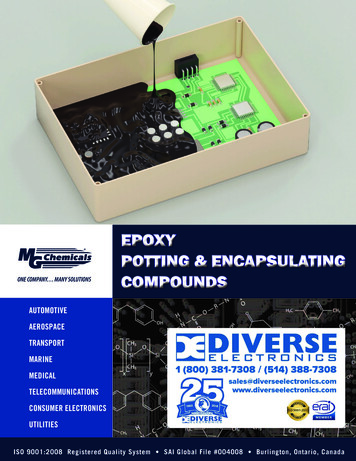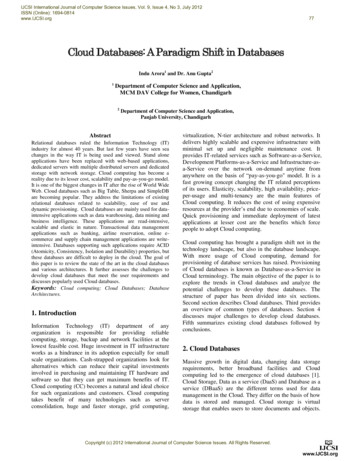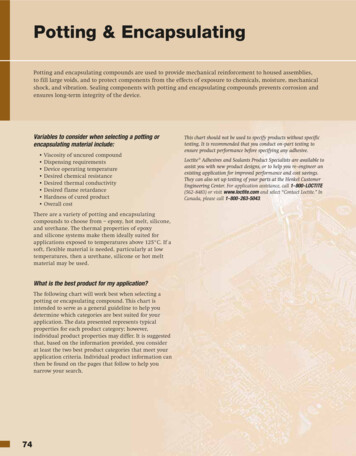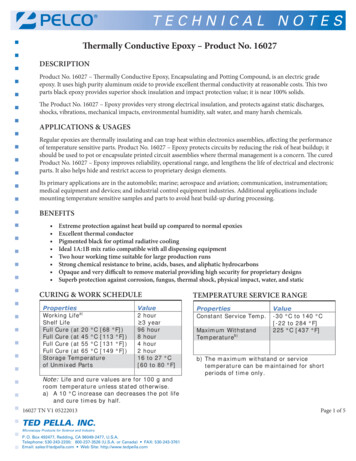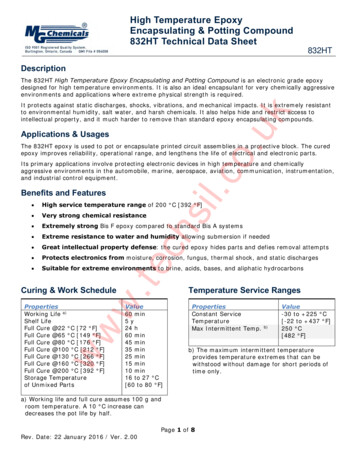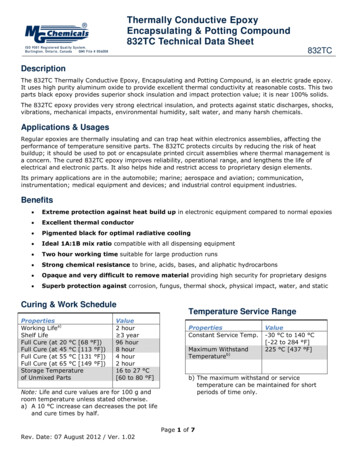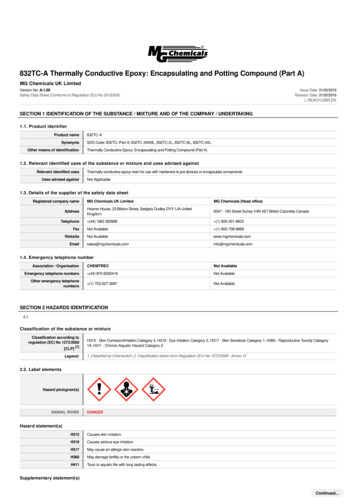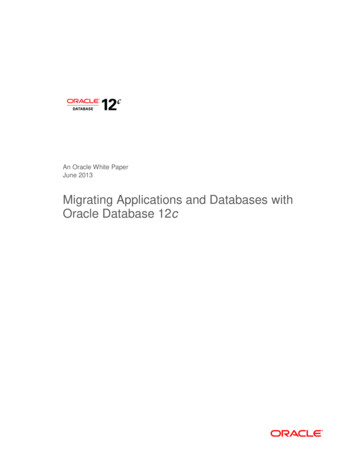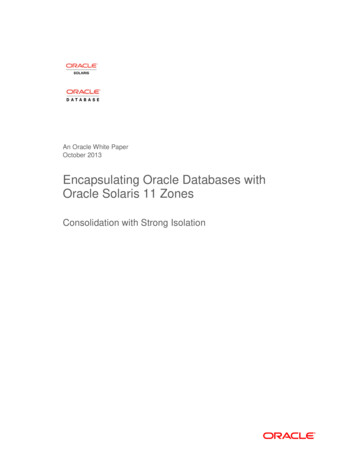
Transcription
An Oracle White PaperOctober 2013Encapsulating Oracle Databases withOracle Solaris 11 ZonesConsolidation with Strong Isolation
Encapsulating Oracle Databases with Oracle Solaris 11 ZonesIntroduction . 3Physical and Logical Encapsulation . 4Isolation in Database Clouds . 5Database Isolation with Oracle Solaris 11 Zones . 6Fault Isolation . 6Operational Isolation. 8Security Isolation . 10Resource Isolation . 11Resource Allocation Changes . 14Resource Metering . 15Conclusion . 15For More Information . 16Appendix A: Oracle Solaris 10 Containers . 17
Encapsulating Oracle Databases with Oracle Solaris 11 ZonesIntroductionIn database cloud deployments, companies host multiple databases for use by various internalgroups (private clouds) or external clients (public or community clouds). Whenever multipledatabases are deployed together on shared infrastructure, the solution must take into accountthe degree of isolation each database will require with respect to faults, operations, security,and shared resources.In many database cloud deployments, Oracle Database features and options will provide therequired isolation. This allows consolidating multiple Oracle databases natively onto a sharedinfrastructure, without the need for further isolation. In native consolidations, all databasesshare a single Oracle Grid Infrastructure. This approach is described in detail in the Oraclewhite paper "Best Practices for Database Consolidation in Private Clouds".Database clouds hosting databases with security or compliance considerations have higherrequirements for isolation. These could include sensitive data with privacy requirements ordata from multiple companies that cannot be aware of each other (that is, a public cloud).Such deployments may need to apply additional technologies or controls beyond thoseavailable in a native consolidation.Implementing higher degrees of isolation can be accomplished by encapsulating eachdatabase environment. Encapsulation can be accomplished with physical or logical isolationtechniques. This paper will describe the options and make a detailed analysis of how OracleSolaris 11 Zones efficiently provide encapsulation to Oracle database clouds.3
Encapsulating Oracle Databases with Oracle Solaris 11 ZonesPhysical and Logical EncapsulationPhysically encapsulating a database dedicates a hardware infrastructure for that database. Dedicatedservers or an isolated system domain within a server are typical approaches. This model is generallynot a preferred cloud model because it does not make efficient use of physical resources: when thedatabase is not busy, unused system resources are idle. If the server is sized for occasional peakworkloads, significant resources will be idle most of the time. Therefore, this model will be applicablefor only the most extreme isolation or performance requirements.Logical encapsulation with virtualization provides high levels of isolation and addresses therequirements of many scenarios that need strong isolation. This allows for databases to beconsolidated by running multiple virtual environments, each hosting a database, on a shared hardwareinfrastructure. By consolidating on shared resources, those resources can be more efficiently utilized.The two options for logical encapsulation are virtual machines (VMs), which are hypervisor-based, andvirtual operating environments, which are OS-based.VMs offer very strong encapsulation. However each VM carries its own software footprint includingan OS instance, which in turn runs its own scheduler and requires its own memory and swap, all ofwhich is managed by the underlying hypervisor. This adds maintenance and performance overheadand I/O latency to the deployment. Since all I/O is managed through a hypervisor, heavy workloadsmay create bottlenecks, leading to unacceptable response times. This is especially true for databasedeployments, which tend to be I/O-bound rather than CPU-bound.Virtual operating environments, such as Oracle Solaris 11 Zones, are a different approach tovirtualization. While a VM is hypervisor-based, an Oracle Solaris Zone is a pure software constructmanaged by a single Oracle Solaris instance (the global zone). Zones provide strong isolation and alsoprovide bare-metal I/O performance. They are so lightweight that thousands could be deployed on asystem with negligible impact on overall system performance. Oracle Solaris 11 Zones are available onany platform—SPARC or x86—that supports Oracle Solaris 11. Some platforms, such as OracleSuperCluster, offer extra capabilities that enhance the value of zone-based solutions.Oracle Solaris 11 Zones provide very strong isolation for applications and are also an administrativeboundary. The applications and users in an Oracle Solaris 11 Zone perceive a dedicated system (forexample, namespace and file system mount points), but in fact they can use only the system resources(CPU, drivers, file systems, and so on) that the administrator of the global zone makes available tothem. Users logged in to a zone cannot see other zones. The administrative commands available in azone are limited, and can be further limited or selectively expanded by the administrator of the globalzone.For readers familiar with Oracle Solaris 10, it is important to note that Oracle Solaris 11 Zones are asignificant evolution beyond Oracle Solaris 10 Containers. Improvements, such as completeintegration with Oracle Solaris 11 networking and simpler lifecycle management, are two importantexamples.4
Encapsulating Oracle Databases with Oracle Solaris 11 ZonesThis paper will describe the isolation that Oracle Solaris 11 Zones provide in a database consolidationdeployment in which each database is encapsulated in its own virtual operating environment; that is,each database is encapsulated in its own Oracle Solaris 11 Zone, as shown in Figure 1. 1Figure 1. Encapsulating Databases in Oracle Solaris 11 ZonesIn this deployment model, multiple zones are provisioned onto physical servers that are clusteredtogether in a cloud pool, and each zone hosts an instance of an Oracle Database 11g Release 2 asOracle Real Application Clusters (Oracle RAC) or as an Oracle RAC one-node database. While thereare several options for allocating and sharing resources among zones, this paper will describe a modelin which resources are partitioned, providing the strongest degree of isolation available with OracleSolaris 11 Zones, enabling the consolidation of tenants who must be thoroughly segregated from eachother.Isolation in Database CloudsThere are four dimensions of inter-tenant isolation to consider in a consolidated environment. Thoseitems and their requirements for strong inter-tenant isolation are as follows: Faults: While the failure of a shared component (such as a server) inevitably impacts all tenants, thefailure of one tenant’s software or dedicated resources should not impact other tenants. Operational: Replacement or maintenance of a shared resource may impact all tenants, but theoperations performed on a specific tenant’s environment should not impact other tenants.Virtual operating environments can be deployed in VMs, for example, Oracle Solaris 11 Zones running inOracle VM Server for SPARC. Also, Oracle Solaris 11 supports Oracle Solaris 10 Zones, which areoperating environments that emulate Oracle Solaris 10. This paper does not examine these deploymentoptions.15
Encapsulating Oracle Databases with Oracle Solaris 11 Zones Security: Each tenant’s data and runtime environment must be shielded from other tenants, andpossibly isolated from the provider of the cloud environment (for example, a tenant in a public cloudshould expect their data to be confidential—the provider cannot read it). Resources: Tenants need sufficient resources to meet their SLAs. Tenants are not able to consumeresources that are not granted to them.Database Isolation with Oracle Solaris 11 ZonesDeploying databases in Oracle Solaris 11 Zones addresses each type of isolation very effectively. Thefollowing tables describe the level of isolation that zones provide. In some cases, this is the same aswhen deploying natively on the operating system, but we will see many examples where zones providestronger isolation, and we will see cases where deploying on Oracle SuperCluster provides addedisolation.Fault IsolationTABLE 1. FAULT ISOLATIONFAILURE TYPESCOPEIMPACT ON CO-TENANTS IN AN ORACLE SOLARIS 11 ZONES ENVIRONMENTHardwareServerThe failure of a cluster node (server) will affect all the database connections that exist on thatnode. This behavior is the same in native deployments.For this reason, databases are deployed in a cluster environment (Oracle RAC or Oracle RACone-node environment) to guarantee continued availability of the database service.Network NICA NIC can be shared by several zones or assigned to a specific zone. In either case, the failure ofor switcha single NIC usually has minor impact since a redundant NIC should be available as a bestpractice.The same is true for a failed switch: as a best practice there should be more than one switch, so asingle switch failure should not cause a service outage for any database.Oracle RAC’s Single Client Access Name (SCAN) should be configured on top of Oracle Solaris IPMultipathing (IPMP) to leverage the multiple NICs available for the public network, and OracleRAC’s Highly Available Virtual IP (HAIP) should be configured for Oracle RAC’s privateinterconnect. For both, the impact of a NIC or switch failure will be the same in nativedeployments.Storage diskSimilar to a network, storage is also designed for resiliency. Any component failures are handledby a redundant partner. For added protection, use Oracle Automatic Storage Managementredundancy to protect against disk failures or even storage failures.Behavior will be the same in native deployments.SoftwareDatabaseA database failure on a native consolidation affects other databases in rare cases such as thefollowing: if an Oracle RAC database instance becomes unresponsive, then one of theneighboring node’s Lock Monitor Services (LMS) processes will request Cluster SynchronizationServices (CSS) to perform a “member kill” operation against the unresponsive instance. In rarecases, where the unresponsive instance cannot be killed, an invasive operation such as nodereboot is invoked. In these rare cases, other database instances will be affected since the entireserver is rebooted.6
Encapsulating Oracle Databases with Oracle Solaris 11 ZonesHowever when databases are deployed in zones, the reboot request will not reboot the entireserver, but only the zone hosting the unresponsive instance. This reboot will be invisible toco-tenants—their zones will continue to operate without any impact from the zone reboot.A further benefit is that a zone reboot is much faster than a server reboot (seconds versusminutes). Therefore, the database in the rebooted zone will come back online faster than if theserver were rebooted.Oracle GridEach database encapsulated in its own zone has its own Oracle Grid Infrastructure. Therefore,Infrastructurethe failure of an Oracle Grid Infrastructure or Oracle Automatic Storage Management instance in aor Oraclezone does not affect databases running in other zones.AutomaticOn a native deployment, there is one Oracle Grid Infrastructure instance shared by all databasesStorageon a node. Therefore, an Oracle Grid Infrastructure failure impacts all databases running on thatManagementnode.instanceGlobal ZoneThe Oracle Solaris 11 global zone operates all of the zones running on the server, so a failure ofthe Oracle Solaris 11 global zone impacts all zones and database instances on the server. Thisimpact is the same as in a native deployment, where all databases are hosted in the global zone.Zone hostingthe databaseA failure or reboot of a zone does not impact other zones or their tenants. Besides addressing thefault scenario described above, per-zone rebooting can be very useful in test environments. If atester wishes to simulate a node reboot and observe its effect on the hosted application, the testercan reboot the zone without impacting any other zones on the server.AdministrativeError orA root user in a zone cannot execute any command that will impact any other zones: the zone isattackan administrative boundary. Since such privileges are not available, any accidental or maliciousattempts to delete or alter other zones are prohibited.This provides a safety net that is not available on native deployments: per-zone administrators canbe given full root privileges to their environments without endangering other environments.Zones can be created from templates (documented in the zonecfg man page). This enablesconsistent, repeatable zone deployments, thus reducing errors that could grant unintendedprivileges.7
Encapsulating Oracle Databases with Oracle Solaris 11 ZonesOperational IsolationTABLE 2. OPERATIONAL ISOLATIONOPERATIONAL SCENARIOIMPACT ON CO-TENANTS IN AN ORACLE SOLARIS 11 ZONES ENVIRONMENTGeneral administrationAn administrator of a zone can operate only on that zone, within the administrative and resourcelimits set forth by the global zone administrator. The zone administrator will perceive a dedicatedsystem and will be able to install and patch software, configure firewalls, monitor network traffic ofthe zone, and so on.This localized authority and visibility are the keys to enabling Oracle Solaris 11 Zones to be usedas the foundation for clouds with effective, delegated administration: each zone owner has thescope to fully manage their environment. This is not possible in a native deployment since eachadministrator would need root privileges in the global zone and would be able to access systemwide resources.Note that root access to the global zone should be given to the smallest possible group ofadministrators since they will have visibility to all devices and file systems in non-global zones.Role Based Access Control (RBAC) allows taking this a step further by creating administratoraccounts with only the minimum set of required privileges.New in Oracle Solaris 11, delegated zone administration offers the ability to grant users access tothe global zone, but only for specific operations on specific zones. For example, an administratorcould be given the ability to reboot their specific zone without any visibility of or control over otherzones.Oracle Grid Infrastructure updatesIn this model, each database has its own Oracle Grid Infrastructure, and each database andOracle Grid Infrastructure combination is in a dedicated zone, so the database and its Oracle GridInfrastructure can be patched and managed together, and independently of any otherdatabase/Oracle Grid Infrastructure installations on the server.In contrast, if multiple databases are consolidated on a native platform, each database on a givennode will share a single Oracle Grid Infrastructure home, and updating that home affects all thedatabases running on the node.Oracle Home updatesIn the model this paper describes, each zone hosts exactly one database and exactly one OracleHome. Therefore, the two can be managed in tandem without impacting any other databases.In a native platform consolidation, a database can have its own Oracle Home or share an OracleHome with other databases. If there are numerous databases with their own homes,management becomes more challenging, particularly if specific naming conventions areemployed.If several databases share a home in a database consolidation, then patching the home willimpact all databases running from that home. Also, any user who is part of the OSDBA group forthat home will have SYSDBA access to all database instances running from that home. (OracleDatabase Vault can be used to address this issue.)OS updates—global zoneAll zones are managed by the global zone. Therefore, any action that affects the global zoneaffects all zones and the databases running in them. For example, upgrading the global zone willaffect every zone in the same manner.To minimize this impact, global zone updates are always made on an inactive boot environment.The active environment is not affected during this operation—all zones and the applications theyhost continue to operate without impact. The new environment becomes active after a singlereboot of the server. (This is the same approach employed in native Oracle Solaris 11deployments.)8
Encapsulating Oracle Databases with Oracle Solaris 11 ZonesOS updates—non-global zoneEach Oracle Solaris 11 Zone on a server runs at the same OS software update level. Therefore,the consolidated databases must all support the same Oracle Solaris 11 software update level;and when one zone is updated, all are updated. In effect, this brings the same “single OSversion” requirement that a native deployment implies.Updates on Oracle Solaris 11One advantage of Oracle Solaris 11 is the ability to quickly switch via reboot back to a pre-systems—generalupgrade environment using an alternate boot environment (ABE). This applies to zone and nonzone Oracle Solaris 11 deployments.Adding devicesA non-global zone must be rebooted to see new devices (such as a storage LUN or networkinterface) after they are assigned from the global zone. This requirement might be lifted in futurereleases of Oracle Solaris 11. Note that rebooting a zone does not impact other zones. Also, byrunning Oracle RAC, the impact of this reboot is mitigated, since services will continue running inthe zone(s) of the Oracle RAC cluster that are not rebooted.Zones hosting Oracle Database 11g Release 2 on Oracle SuperCluster offer an advantage forstorage management when Oracle Exadata Storage Servers are used. In this scenario, theOracle Database 11g Release 2 instance doesn't manage "local" disks or devices presented viaOracle Solaris. Instead it communicates with Oracle Exadata Storage Servers with a specialprotocol over InfiniBand. Oracle Exadata Storage Servers manage the physical disks, so thedisks are not seen directly by Oracle Solaris. In this environment, additional storage can bepresented to the zone and the Oracle Database 11g Release 2 instance without rebooting either.On all Oracle Solaris platforms, the global zone sees new devices dynamically, with no rebootneeded.Backup/recovery of zone contentsBackups can be done at the zone level by running a backup client in each zone. If the backup(including Oracle Home)data from each database must be kept separate from the others, then each backup client willconnect to its own file system.If the backup data for each database can be stored in a single file system, each zone could mounta single shared file system provided by the global zone. This reduces the number of file systemsto manage (though note that the data from each zone is not isolated in this case).If the entire backup activity can be centralized, backups can be controlled from the global zoneand the backup data written to backup devices that are connected to and visible in the global zoneonly. Compared to a per-zone backup architecture, this reduces complexity and can lead tosignificant savings of bandwidth.Recovery of a zone is much faster than recovering a system, because it involves simply an“unpack” of an archived zone installation.Migrating a zone to anotherA zone can be cold-migrated to a zone on another physical system. The zone on the sourcesystemmachine is halted and detached before being attached on the target server.The source and target servers can be running different releases of Oracle Solaris 11; the targetsystem must have the same or later versions of the operating system packages. See the“Migrating Oracle Solaris Systems and Migrating Non-Global Zones” chapter of the “OracleSolaris Administration: Oracle Solaris Zones, Oracle Solaris 10 Zones, and ResourceManagement” guide.9
Encapsulating Oracle Databases with Oracle Solaris 11 ZonesSecurity IsolationThe security isolation provided by Oracle Solaris Zones applies to both administrative and runtimeconsiderations. Oracle Solaris 10 Zones has been evaluated under the Common Criteria at EvaluationAssurance Level 4 . Oracle Solaris 11 Zones technology is currently under evaluation. 2TABLE 3. SECURITY ISOLATIONSECURITY ISOLATION USE CASESECURITY HANDLING WITH ORACLE SOLARIS 11 ZONESAdministrative privileges in aAmong other default limitations, the zone root user cannot create devices; other limitations may bezonedefined when the zone is created. These privileges may be modified—either relaxed or furtherrestricted—by the global zone administrator after zone creation. After such a change, the zonemust be rebooted for the (persistent) change to take effect.Because of the reduced privileges for a zone root user, many customers consider a zone a saferdatabase operating environment than the global zone, since this “restricted root admin” concept canbe applied.Note that root access to the global zone should be given to the smallest possible group ofadministrators since they will have visibility to all devices and file systems in non-global zones.Additionally, RBAC should be used to provide administrative granularity.File/storage accessOracle Database Vault should be used to protect client data, so that even the cloud provider cannotread the client data. This applies to native deployments as well.Network traffic securityIn most data centers, network switches will be shared by NICs from multiple server pools.Point-to-point traffic between associated NICs can be isolated by assigning them to dedicatedVLANs (virtual LANs). This is a common best practice even in non-cloud deployments.Oracle Solaris 11 provides the ability to create VNICs (virtual network interfaces). A physical NICmay host one or more VNICs. A VNIC can be assigned to a VLAN, and this isolates the end-to-endtraffic between VNICs on that VLAN.When a VLAN is assigned to a non-global zone’s VNIC, the traffic is fully isolated and othernon-global zones cannot see that traffic. So if all non-global zones on a node are given their ownVNICs, and those VNICs are grouped in properly segregated VLANs, then a root user in any givenzone will be able to see only the traffic routed to that zone. For example, a root user in a zone couldrun snoop and would see only the traffic routed to that zone.By default, the zone administrator will have the ability to spoof MAC and IP addresses. The globalzone administrator can prevent this by setting the “allowed-address” property on the zone. Also, theData Link Protection feature can be used in the global zone to manage the protocols that can besent by a non-global zone.See security-evaluations-099357.html for moredetails.210
Encapsulating Oracle Databases with Oracle Solaris 11 ZonesResource IsolationTable 4 describes how to achieve resource isolation with zones. Later sections describe how to changeallocations and observe resource usage.TABLE 4. RESOURCE ISOLATIONRESOURCERESOURCE ISOLATION WITH ORACLE SOLARIS 11 ZONESMemoryThe deployment model described in this paper assumes that every database on the system could beactive at the same time. Therefore, we will allocate memory in a manner that will prevent memorypaging, which would cause performance issues.Memory use by a zone should be limited by setting a maximum value on the amount of virtualmemory that can be allocated by processes in the zone.The global zone administrator defines the virtual memory available to each zone at zone creationwith the “swap” property of the “capped-memory” resource. This defines the maximum amount ofvirtual memory that the zone will be allowed to use.To prevent paging, we must ensure that there is enough physical memory to handle all of the zonessimultaneously. First, we will reserve 4 GB of memory for global zone operations; 4 GB for the ZFS3ARC cache ; and 1/32 of the total physical memory for free pages. So on a system with 512 GB,4we would have 512 – (4 4 16) 488 GB to allocate to zones .Remember that we will limit the virtual memory of each zone; that is, the sum of all allocated virtualmemory must be no more than 488 GB in our example. We do not limit physical memory for eachzone in this model.In addition to predictable, optimal memory use, limiting virtual memory has an added benefit: if aDBA (accidentally or otherwise) assigns SGA/PGA values that exceed the zone’s virtual memory(swap) limit, the database will not start. Without this limit, a DBA could “steal” memory from otherzones, impacting other users and workloads.This control is not available for managing applications running in the global zone.Note: Oracle Solaris Dynamic Intimate Shared Memory (DISM) should not be used with the Oracledatabase. Because of this, changes to the SGA size are not dynamic as noted in the ResourceAllocation Changes table (Table 5).Although ZFS is not used as the data store, it is always active in an Oracle Solaris 11 environment. If theARC cache is not limited, it will occupy a large amount of memory during system startup. This will delaystartup of the databases. Hence, the recommended limit on ZFS ARC cache.34To fine-tune the amount of memory reserved for the global zone, the zonestat utility can be used toshow how much memory the global zone is using. That memory will be listed as system. This value doesnot include the ZFS ARC.11
Encapsulating Oracle Databases with Oracle Solaris 11 ZonesCPUBefore allocating CPU capacity to non-global zones, the amount of CPU that will be reserved for theglobal zone must be considered. Although most of the processing for a non-global zone isperformed by the CPUs assigned to the zone, the global zone manages the overall system includingI/O. Assigning one core (from a SPARC T-Series or SPARC M-Series server from Oracle) to theglobal zone will typically be sufficient. However, if applications are deployed in the global zone (notrecommended) or the deployment has high I/O, the CPU needed by the global zone may be higher.For assigning CPUs to non-global zones in this deployment model, CPU resources are allocated toa zone by creating a resource pool; assigning a processor set to the resource pool; and attachingthe resource pool to the zone.On a hyper-threaded server, the CPUs (that is, threads) assigned to a zone should be from thesame socket. For a zone running Oracle Database, it is not necessary to assign threads from thesame core of a SPARC T-Series machine. Threads on the same socket provide sufficient proximitysince they have the same distance from the common memory.This approach guarantees the processing capacity available for the zone. Also note that thisapproach is recognized by Oracle as a hard partition for software licensing56.In a native deployment, CPUs can be allocated using Oracle Solaris Projects or, preferably,managed with the database’s Instance Caging feature.LWPsThe maximum number of lightweight processes should be limited for the zone. This will preventsystem-wide impact from an administrative error or misbehaving application that creates very largenumbers of processes or LWPs: if the maximum number of processes or LWPs for the system isreached, the global process table of the global zone will fill up and no more processes can becreated by any user or processes within a zone.To determine the proper value, the zone should be observed over time to monitor the processbehavior. A value should be selected that will provide headroom and prevent excessive use. For azone running Oracle Database 11g Release 2, a typical value will be in the range of 5,000 to10,000.In a native deployment, processes can be limited using Oracle Solaris Projects or, preferably,managed with the database’s Instance Caging feature.ProcessesAs with LWPs, processes should be observed on a well-behaving system, and an appropriatemaximum applied for the zone.See laris-168405.pdf for specifics and tytopics/index.html for additional licensing topics relevant to database cloud deployments.56There are other approaches available for allocating and sharing CPUs among zones, but they are notrecognized by Oracle as hard partitions for software licensing.12
Encapsulating Oracle Databases with Oracle Solaris 11 ZonesNetwork trafficThe traffic of each VNIC is segregated from other VNICs down to the data link layer; therefore,when a VNIC is assigned to a zone, that zone owns what appears to be a physical link. Thezone’s administrator can apply IP operations such as configuring IP Filter and IPsec. The OracleSolaris 11 Network Interfaces and Network Virtualization administration guide (see the section “ForMore Information” for a pointer to this guide) refers to this as a basic virtual network. It is one ofthe key Oracle Solaris 11 features enabling the creation of virtual private clouds, since zoneadministrators have greater flexibility but remain isolated from other zones on the system.Each VNIC can be assigned a bandwidth limit by the global zone administrator with the maxbwp
Oracle VM Server for SPARC. Also, Oracle Solaris 11 supports Oracle Solaris 10 Zones, which are operating environments that emulate Oracle Solaris 10. . Oracle RAC's Single Client Access Name (SCAN) should be configured on top of Oracle Solaris IP Multipathing (IPMP) to leverage the multiple NICs available for the public network, and Oracle .
